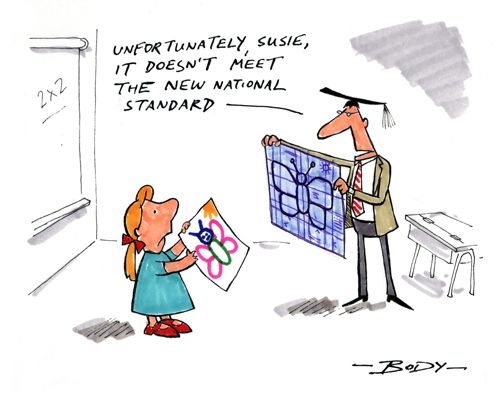
The first week of my study abroad experience was very interesting. Although our travel plans to Jamaica were canceled, I am hopeful that this virtual experience will be very insightful. The first week was an introductory course into why embracing cultural diversity is so important in our classrooms. From this discussion, I learned about the downfall of having a “singular story.” Look down below at the picture I have included in this blog. The teacher in this picture is rejecting Susie’s drawing of a butterfly. Notice the lack of color and uniqueness in the teacher’s picture; it seems to resemble a blueprint model compared to Susie’s colorful picture. Contrary to how innocent this exchange seems, this is what many students from immigrant families have experienced. This picture illustrates the danger of what novelist, Chimamanda Adichie, describes in her TED Talk as the “singular story.”
The “singular story” is the process of viewing a specific concept or trait through a narrow lens based on proximity, experience, or stereotypes. I believe one profound example of this is Ms. Adiche’s reason for writing her novels. When she was in school in Nigeria, the only books that she read were classic British novels that were centered on Caucasian protagonists who “talked about the weather.” As a result of this, she went through a major education identity crisis when she began writing. Because she assumed that all prolific novels were centered around Caucasian protagonists who “talked about the weather,” she didn’t see herself as a writer because she couldn’t connect to those stories. It wasn’t until she discovered African authors such as Chinua Achebe that she was empowered to tell stories for young ladies like her who were seeking a connection through literature. This made me think about why so many students from immigrant families may struggle to transition into the culture of the American school system. It’s very hard to exist between two cultural worlds when the American school system lumps so many diverse cultures into vague labels and statistics. Moreover, from this discussion, I realized, as teachers, we must not govern classrooms by this “singular story”. The Caribbean culture is deeply rooted in the pride of their heritage. Dominicans, Haitians, and Jamaicans all embrace their traditions and historical victories.
One interesting conversation that one of my classmates emphasized was the perspective of “being black” in America versus being a Caribbean American. Unfortunately, the government and other social institutions don’t acknowledge one’s specific roots, as well as other countries, do. Many Caribbean students will acknowledge their heritage before taking on the racial label of “black.” This doesn’t mean they are refuting the label, as this is a major misconception. It means they are establishing and reaffirming their origins. As teachers, we must learn how to respect this and allow students to have a platform to express their heritage to expand the mindsets of others. I look forward to having more conversations like this during my virtual study abroad experience.
